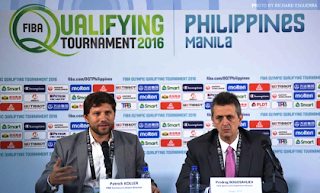With the adoption of a new competition format and calendar starting 2017 by FIBA, it is not certain yet how the Philippine Basketball Association (PBA) players will be able to squeeze it in their schedule.
Among the key changes adopted by the world governing body for basketball are: moving the FIBA Basketball World Cup from 2018 to 2019, in order to avoid clashing with the FIFA World Cup; increasing the number of participating teams from 24 to 32; and putting teams from Asia and Oceania together in one Asia-Pacific region.
There will now be a two-year qualification period for each FIBA World Cup, with home-and-away games being played in "competition windows" scheduled on November, February, June, September, and again in November and February.
Moreover, qualification for the Olympics games will be through the FIBA World Cup, and four Olympic Qualifying Tournaments.
For the Gilas Pilipinas program, this means that national basketball team will be more active, instead of playing in just one major tournament every summer. They will also be more "visible," thanks to the home-and-away format that requires them to play in their home floor during the competition windows.
The FIBA competition windows, however, will be in conflict with the schedule of the PBA. According to FIBA officials, it will be up to the PBA and the Samahang Basketbol ng Pilipinas (SBP) to resolve this issue.
"It is the responsibility of the national federations to discuss with the local league and open the window for the national team program," Predrag Bogosavljev, FIBA's sports and competitions director, said last 11 July.
"But we tried to minimize the impact on the national league," he added.
Each competition window will last for nine days, and the national team will only be play two games in those windows, unlike the packed schedule of summer tournaments.
The SBP has tried to get ahead of this problem by reforming the Gilas Cadets program, wherein former collegiate stars will now be called upon to represent the country as the Philippines hopes to qualify for the FIBA World Cup in 2019.
Among the key changes adopted by the world governing body for basketball are: moving the FIBA Basketball World Cup from 2018 to 2019, in order to avoid clashing with the FIFA World Cup; increasing the number of participating teams from 24 to 32; and putting teams from Asia and Oceania together in one Asia-Pacific region.
There will now be a two-year qualification period for each FIBA World Cup, with home-and-away games being played in "competition windows" scheduled on November, February, June, September, and again in November and February.
Moreover, qualification for the Olympics games will be through the FIBA World Cup, and four Olympic Qualifying Tournaments.
For the Gilas Pilipinas program, this means that national basketball team will be more active, instead of playing in just one major tournament every summer. They will also be more "visible," thanks to the home-and-away format that requires them to play in their home floor during the competition windows.
The FIBA competition windows, however, will be in conflict with the schedule of the PBA. According to FIBA officials, it will be up to the PBA and the Samahang Basketbol ng Pilipinas (SBP) to resolve this issue.
"It is the responsibility of the national federations to discuss with the local league and open the window for the national team program," Predrag Bogosavljev, FIBA's sports and competitions director, said last 11 July.
"But we tried to minimize the impact on the national league," he added.
Each competition window will last for nine days, and the national team will only be play two games in those windows, unlike the packed schedule of summer tournaments.
The SBP has tried to get ahead of this problem by reforming the Gilas Cadets program, wherein former collegiate stars will now be called upon to represent the country as the Philippines hopes to qualify for the FIBA World Cup in 2019.


No comments:
Post a Comment